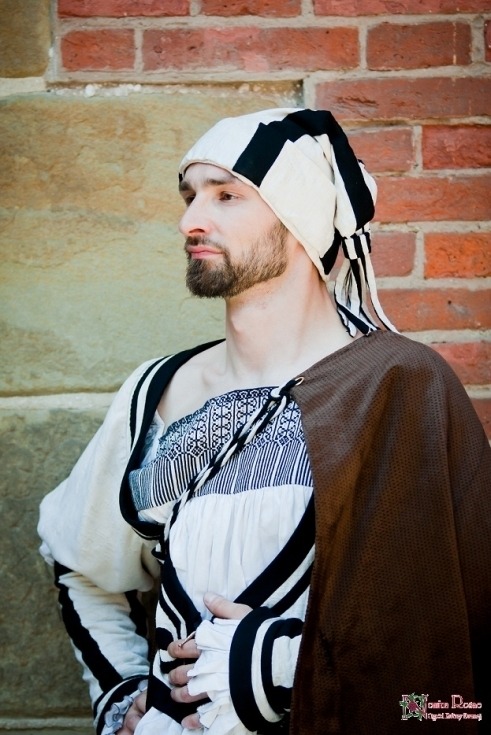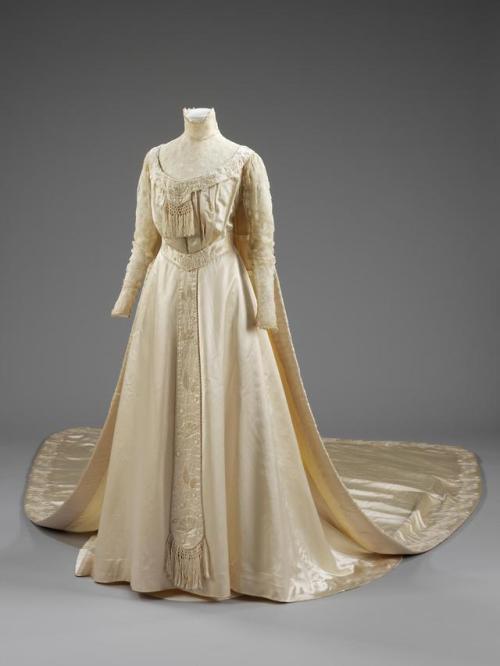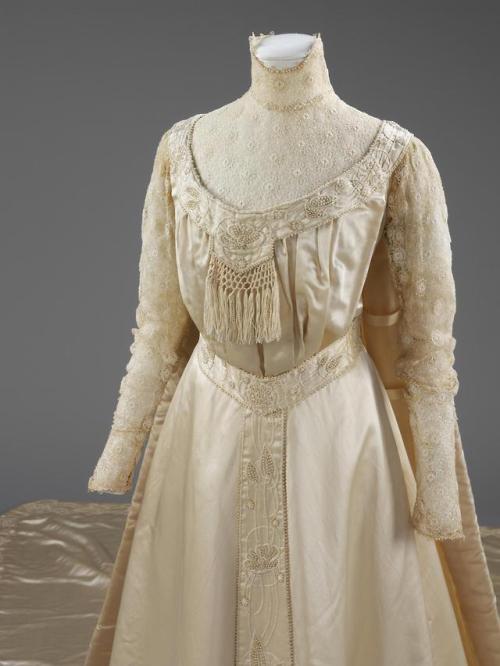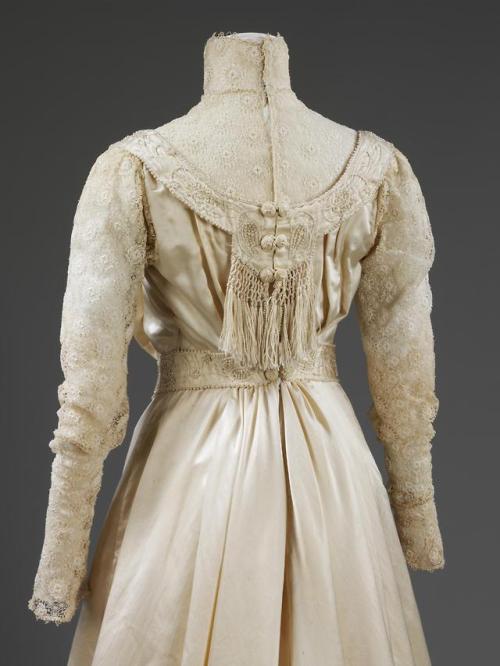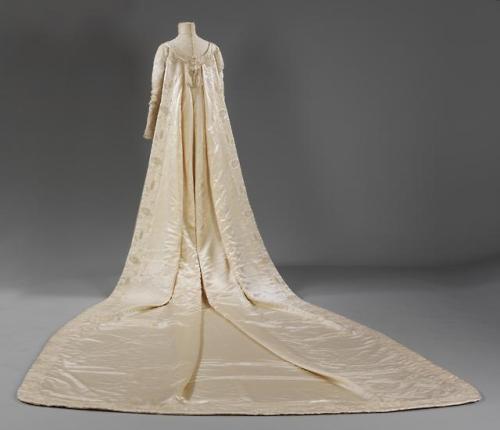#historical clothing
Tempus Fugit. Keep making art.
Replica House of Worth 1898 ironwork gown made and worn by Cynthia Settje of Redthreaded
https://redthreaded.com/blogs/redthreaded/tagged/worth-gown
Photography: Merritt Portrait Studio
Jewelry: Dames a la Mode
HMUA: Lauren Rennells Location: Denver Clock Tower
Post link

“Once we know what to look for, retouching becomes quite obvious. It is there in the smooth cheeks of Edwardian women, in the impossibly sloped shoulders of debutantes, in the famous waist of Polaire.”
The camera has been lying for over 100 years. Read more…
I found a treasure! (that everyone probably already knew about but me)
I’m in the middle of my exam season right now and I’m almost done (yay!) so I don’t have any projects in progress right now, but I still wanted to share something.
For the longest time it’s been a dream of mine to own an Edwardian gown. I keep raving about everything Edwardian on this blog but I’ve never really had the courage to make anything myself because damn, the amout of skill that you need! But I was recently browsing through archive.org looking for some old fashion magazines to find some Edwardian bodices for inspiration cause I wanted to make something actually wearable in the 21st century. Long story short, I found nothing but I came across two The Voice of Fashion magazines, both from the 1890s (Winter 1897andFall 1897) and I felt like I’d found a treasure. All of the magazines I had come across before were usually fashion magazines where you could order something and it’d take about two months (incredible, right?) to arrive. But not this one, not The Voice of Fashion.
They were full of patterns - actual, original 19th century patterns to make these gowns at home. So I quickly looked up those magazines on google to see if there was more and it turns out there is an entire book, a compilation of 14 magazines ranging from 1900-1906. So naturally, I had to buy it and it’s the most beautiful thing I’ve ever owned and I cannot wait to actually make something from that book!

Here are some of my favorites:






And that’s not all! There are also some patterns for underwear (here’s a chemise I’ve been wanting to make for a while).

There are also hats and shirtwaists!

This is what a random pattern looks like. The system is very easily explained and I love that it doesn’t just stop at the pattern but there’s a short instruction as well!

So… I think these patterns and instructions are actually making me feel like I can do it? And it’s incredible to think that one day, hopefully soon, I will actually own one of these beauties!!!
So yes, I got really excited over a book and I hope I could share some of that excitement with you. I hope I can get back to sewing as soon as I finish my exams! Actually, I sort of have to make a petticoat next week so we’ll see how that works out.
Until then, stay healthy and if you’re in the middle of exam season like me, good luck, you can do it!!




- Hairstyle Based On Eastern Han Dynasty tomb murals unearthed in Xingyang City, Henan Province:

[Hanfu · 漢服]China Eastern Han Dynasty Chinese Traditional Clothing Hanfu & Hairstyle Based On Eastern Han Dynasty Mural
___________________________
- Recreation Work:@晓琳-装束
- Photo:@安小心HL
- ♀️Model :@何首呜qaq
- Hanfu:@桑纈
- Weibo:https://m.weibo.cn/3190438345/4769102567312775
___________________________
[Hanfu · 漢服]China Tang Dynasty Chinese Traditional Clothing Hanfu in TV Show《爱奇艺登场了洛阳》with Actor @娄艺潇
【Summary】
Actor Lou Yixiao (娄艺潇) plays Wu Zetian, and holds a prayer ceremony under the “Loshena Buddha Statue” in the Longmen Grottoes in Luoyang.
The statue of Lusena Buddha was excavated in the third year of Xianheng, Emperor Gaozong of Tang Dynasty (AD 672). Wu Zetian, who was the empress of Li Zhi at the time, she donated 20,000 money to the project, which is equivalent to more than 6 million Yuan (CNY) today in terms of the price of food at that time.
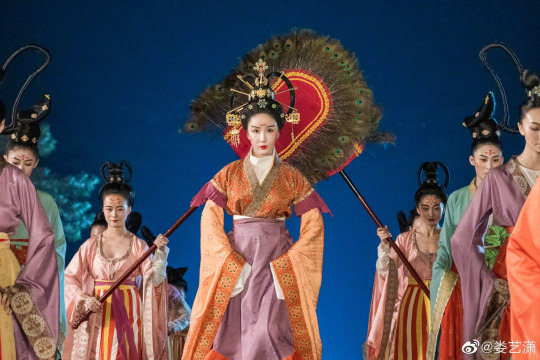



【Hanfu and Hairstyle Culture Relics Reference】:

・"Stone Carvings of the Emperor and Empress of the Tang Dynasty“
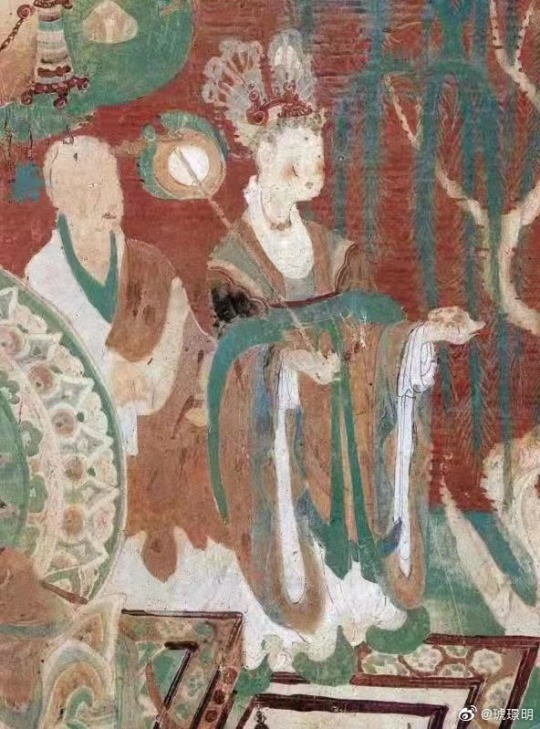
・The Image of the Empress of the Tang Dynasty in Dunhuang Murals
Recreation Work By:@桑纈
[Hanfu · 漢服]China Tang Dynasty Chinese Traditional Clothing Hanfu, HairstyleBased On TangDynasty Female Pottery Figurines
- Recreation Work By: @ 蘭萦ying
- Model:你的琳琳
- Weibo:https://weibo.com/2784117073/LqclYg7Pz
Post link


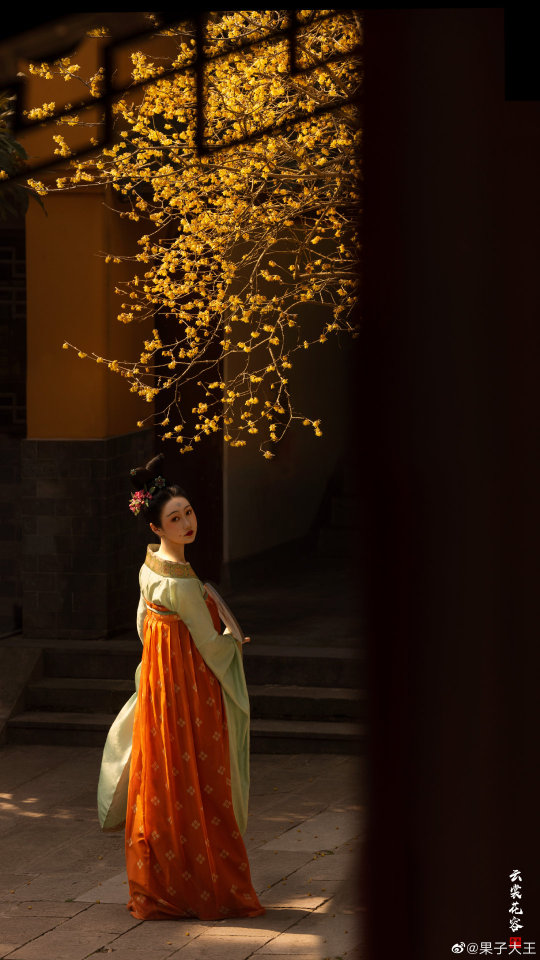




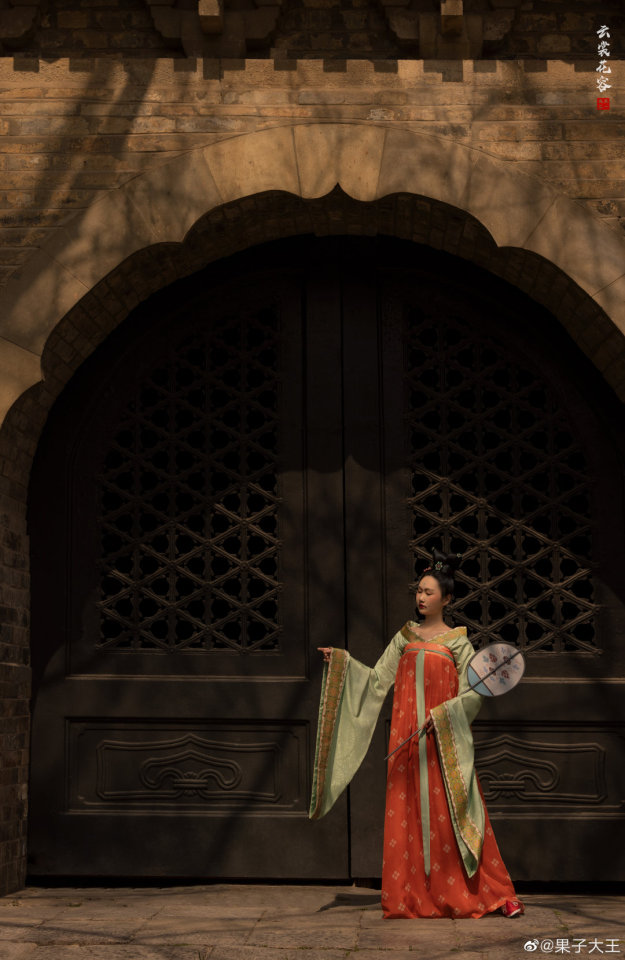
[Hanfu · 漢服]China Tang Dynasty Chinese Traditional Clothing Hanfu Photoshoots: Early Tang Period
Women’s hairstyles and costumes in the early Tang Dynasty Period
_______________________
Model:@沈珍珠奶茶
Styling:@晓琳-妆束
Photo:@果子大王
Hanfu:@桑纈
Weibo:
_______________________
・Based On China Eastern Han Mural: “Couples in Feast 《 夫妇宴饮图 》”

・Hair ornament based on Han Dynasty Gold “BuYao步摇” (is a type of Chinese women’s hair ornament) unearthed in Wuwei, Gansu:

[Hanfu · 漢服]China Eastern Han Dynasty Chinese Traditional Clothing Hanfu, Hairstyle Based On Eastern Han Dynasty Mural and Relics
- Recreation Work By: @ Niki-镜子
- Photography:徐向珍老师
- Model: 喜悦
- Post-production:爱神
- Hanfu:装束与乐舞
- Weibo:https://weibo.com/1730238267/JccMihiFK
Post link
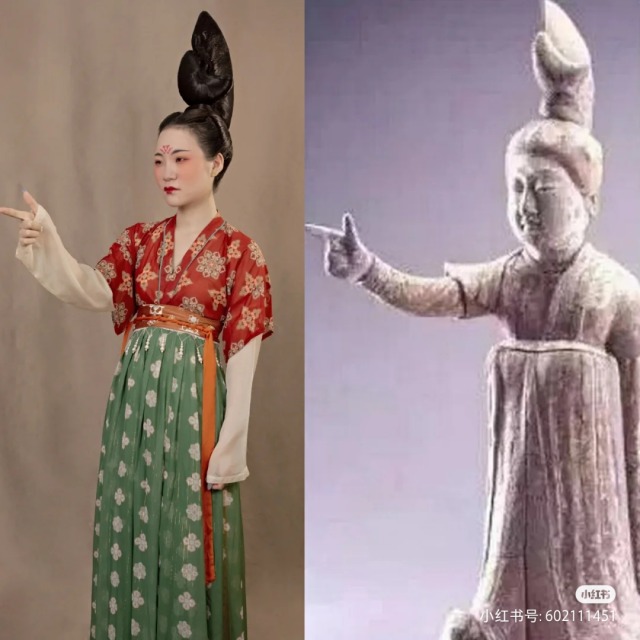
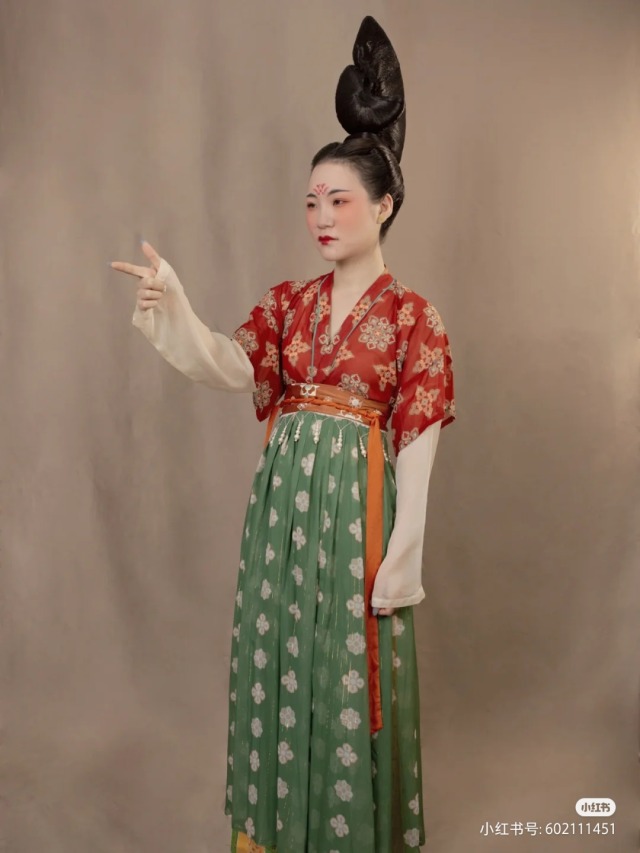





- Hairstyle Based On: Female pottery figurines unearthed from Tang Dynasty Wang Hui’s tomb in Changzhi, Shanxi

[Hanfu・漢服]ChinaTang Dynasty Chinese Traditional Clothing Hanfu & Hairstyle Based On Tang Dynasty Female Pottery Figurines
Photo & Styling:@西安结香令老板娘-蘭索
Model:@月熙熙kirs
小红书XiaoHongShu:










[Hanfu · 漢服]China Tang DynastyChinese Traditional Clothing Hanfu Photoshoots
Emperor Xuanzong of Tang(713 - 741)Period Woman’s Costume, Hairstyle & Makeup
Photo&Styling:@松果sir
Model:@清若空-
Hanfu:@桑纈
Weibo:
[Hanfu · 漢服] Type of Women’s Hairstyle In China Song Dynasty
Video By :@Niki-镜子
———————–——————
【Hairstyle Name in History】:
- 鸾髻(Luán Jì)
- 高椎髻 (Gāo chuí jì)
- 珠髻 ( Zhū jì )
- 包髻 ( Bāo jì)
- 罗髻( Luō jì )
- 懒梳髻( Lǎn shū jì )
- 盘福龙( Pán fú lóng )
- 盘髻( Pán jì )
- 同心髻( Tóngxīn jì )
- 双蟠髻( Shuāng pán jì )
- 云鬟髻( Yún huán jì )
- 朝天髻( Cháotiān jì )
- 双鬟髻( Shuāng huán jì )
- 女冠( Nǚ guān )
- 布裹( Bù guǒ )
———————–——————
The video only mentions some Song Dynasty hairstyles, not all Song Dynasty hairstyles.
Sewing Medieval Bathhouse Dress
I’m a big boob person and for me bras have always been very uncomfortable. They never support enough even with the metallic wire support as the elastic strap is not secure enough and that wire curve is also just uncomfortable. My shoulders are also always aching because of the pressure put on shoulders. But no bras is even more uncomfortable especially if I have to do anything else than sitting. Which is why I have been considering testing out historical options ever since I got into historical sewing.
When it comes to historical sewing (and to some extent sewing in general) I’m still a noob and so I have been quite intimidated by stays and corsets and I’ve figured I’ll start with medieval supportive garments, like kirtle, as they are much simpler. Then I saw the videowhere Morgan Donner made a bathhouse dress and I immediately wanted to test it out too.
Some history
Bathhouse dress is a garment that appears around 14th to 16th century in central Europe, mostly around Bohemia, Austria and German states and their vicinity. Perhaps the most famous finding of this garment is the Lengberg Castle Bra found in Austria.
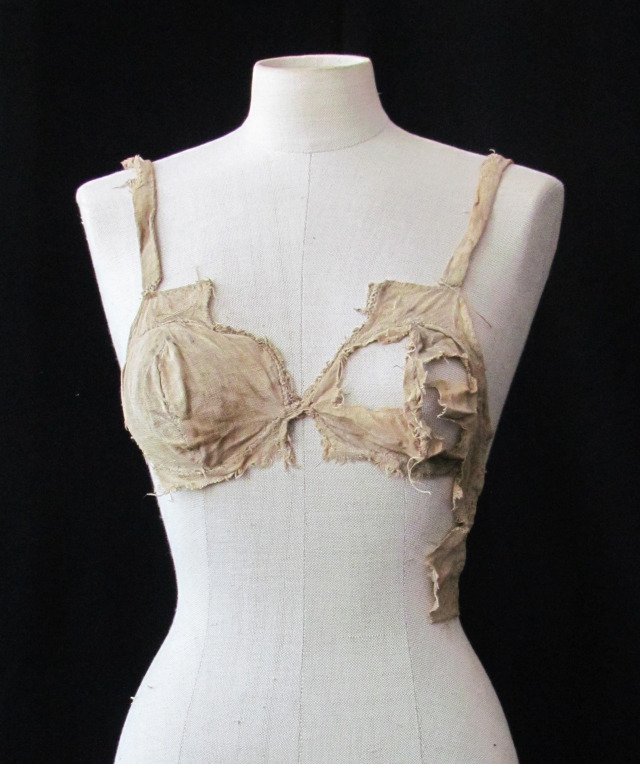
It’s often called medieval bra because it has cups like bra. I think that’s somewhat misleading as it was a full dress and this is just fragments of the dress. There’s theory that there’s only this left because the larger continuous pieces of linen were cut off and used for some other garment. The dress was quite different from shift, the usual loose undergarment that would be used under supportive kirtle around most of Europe at the time. It was sleeveless and tailored with lacing, usually on the side. The reason it’s often called bathhouse dress is that there’s a lot of depictions of it in bathhouse use, especially in Bohemia, and these depictions are sometimes referred as Bohemian bathhouse babes.

All of these types of garments didn’t have cups like this example from 1389 Bohemia, and there were a lot of different designs. There’s different shaped bodices, some had waist seem, some didn’t. In German the garment with cups was called breastbag at the time. In the literary mentions there was often degrading tone when talking about it, and it seemed that the writers at least thought women who used breastbag were “showing off”. When have men not complained about women’s fashion in a patriarchal society? Perhaps with the other designs there wasn’t similar derision. The writings and some other depictions of the garment suggest that it was used more generally as an undergarment and not just for bathhouse. Which would make sense as it would seen uncharacteristic for Middle Ages to tailor a supporting garment (not cheep) just to use in bathhouses.

Here’s a potter wearing similar garment with different design from late 15th century Austria.

Another one from mid 15th century Austria of a woman putting clothes on and obviously wearing the dress as undergarment.
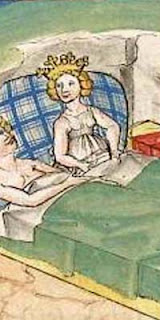
Here’s a German example from late 15th century of a woman wearing it as a nightgown, which shift was also used for.
The sewing part
If you want a tutorial, go and watch that Morgan Donner video linked in the beginning, I’m not a good source on sewing, especially historical.
I wanted to make my version of the dress fairly historical, but I wasn’t too concerned with making in exactly right as it’s purpose is for daily use and not historical costuming. I hand-sewed it with historical techniques though, but the patterning part was quite chaotic and I basically came up with it as I went so there ended up being some weirdness in finishings as I didn’t plan far enough.
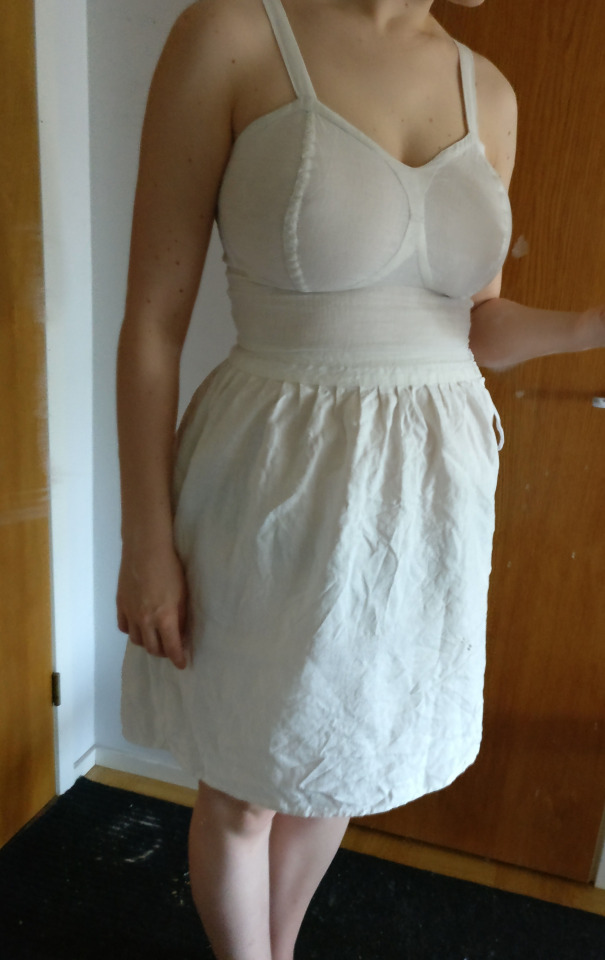
So here’s how it turned out. I very intentionally made it much shorter than it should be. Most depictions have it reach half calf. I was making it for daily use and not historical costuming and I have a lot of knee length skirts, so I wanted it short enough for that. I actually made the bodice and skirt into separate pieces that are just loosely whipstitched together so I can use them both alone too, especially the bodice with trousers.

The shape of the bodice isn’t historical. The cleavage goes fairly high and is fairly straight in most of the historical examples (especially with the cups). Even the Lengberg bra originally had crochet covering the chest area. But again that wouldn’t have fitted so well with a lot of my modern clothing, and my purpose wasn’t historical recreation.


As I was talking about the pretty weird finishings, here you can see them. The result isn’t very neat, but it’s fine.
I have been wearing this now a couple of months and I’m in love with it. It’s much more supportive while being also so much more comfortable. The lacing on the side distributes the force around the waist, so it doesn’t put nearly as much pressure on my shoulders. It’s made entirely out of linen and is very nice against skin and as it doesn’t have any metallic wires it also doesn’t press anywhere. It also is just much more flattering than bras at least for me. It doesn’t work that well without the skirt, the waist starts wrinkling and moving up, but the skirt keeps it pretty straight. The bodice is also slightly too long and it doesn’t sit exactly on my waist, so it adds to the problem. It’s not a huge problem though, it’s just a bit annoying.
I’m planning to test out a version where I’ll reinforce the eyelets with synthetic baleen instead of cord and put baleen in the other side too and maybe in the center front so I could use it as a separate undergarment without the annoying wrinkling. I’m also planning on doing 16th century kirtle bodice or the full kirtle (or both maybe as separate but attachable pieces, like with the bathhouse dress) with either stiff interlining or boning and Regency short stays. I want to test out different types of supportive undergarments in my quest for better bra options. Maybe after I’ve done them I’m ready to try Victorian corset too.
ab. 1905 Wedding dress by Liberty & Co. Ltd.
silk satin embroidered with silk thread, pearls, lace and silk fringe, boned and lined with silk
(Victoria and Albert Museum)
Post link

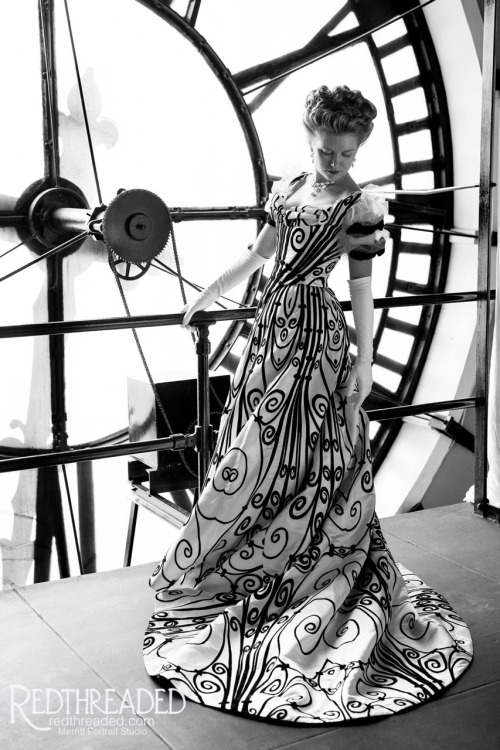
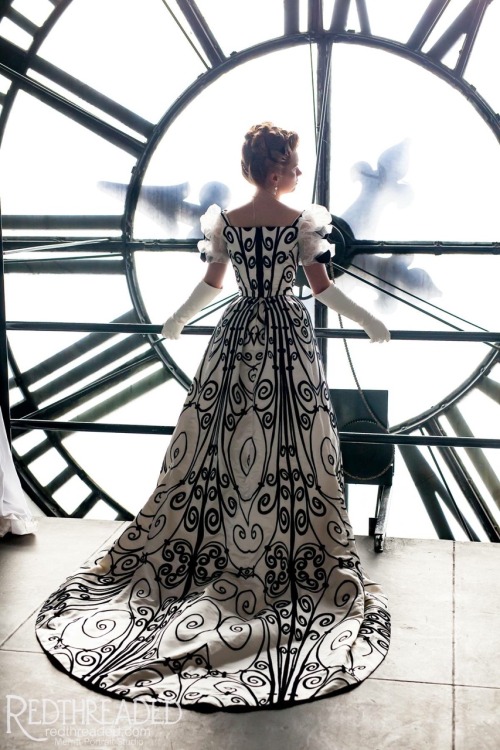

![[Hanfu · 漢服]China Tang Dynasty Chinese Traditional Clothing Hanfu, Hairstyle Based On Tang Dynasty F [Hanfu · 漢服]China Tang Dynasty Chinese Traditional Clothing Hanfu, Hairstyle Based On Tang Dynasty F](https://64.media.tumblr.com/de581356817ab1f3531a3f437c6173cc/7471487702f32fb7-d1/s500x750/662120934c6a5cbc78d42514d130799a3703d6cd.jpg)
![[Hanfu · 漢服]China Tang Dynasty Chinese Traditional Clothing Hanfu, Hairstyle Based On Tang Dynasty F [Hanfu · 漢服]China Tang Dynasty Chinese Traditional Clothing Hanfu, Hairstyle Based On Tang Dynasty F](https://64.media.tumblr.com/3572434a84588fdf195321c877f2f54c/7471487702f32fb7-5a/s500x750/494c635490674bec763e38890e2728b0b8c02f6c.jpg)
![[Hanfu · 漢服]China Tang Dynasty Chinese Traditional Clothing Hanfu, Hairstyle Based On Tang Dynasty F [Hanfu · 漢服]China Tang Dynasty Chinese Traditional Clothing Hanfu, Hairstyle Based On Tang Dynasty F](https://64.media.tumblr.com/c63516b253756a75203f583ed1bf02f8/7471487702f32fb7-c0/s500x750/da03f6087f6e4aa19d0d3f28a954fe3e773c9103.jpg)
![[Hanfu · 漢服]China Tang Dynasty Chinese Traditional Clothing Hanfu, Hairstyle Based On Tang Dynasty F [Hanfu · 漢服]China Tang Dynasty Chinese Traditional Clothing Hanfu, Hairstyle Based On Tang Dynasty F](https://64.media.tumblr.com/aeb33e7d8fe26d5fa5f76a2ad0475c6b/7471487702f32fb7-57/s500x750/7178c1e9773b33571f2df5e2acd5398336a1bedb.jpg)
![[Hanfu · 漢服]China Tang Dynasty Chinese Traditional Clothing Hanfu, Hairstyle Based On Tang Dynasty F [Hanfu · 漢服]China Tang Dynasty Chinese Traditional Clothing Hanfu, Hairstyle Based On Tang Dynasty F](https://64.media.tumblr.com/f07bc81c342e511cae6fc2048a0b0807/7471487702f32fb7-0c/s500x750/385c02cb7df58ca9047ad2fe2c9d89540efbe4de.jpg)
![[Hanfu · 漢服]China Tang Dynasty Chinese Traditional Clothing Hanfu, Hairstyle Based On Tang Dynasty F [Hanfu · 漢服]China Tang Dynasty Chinese Traditional Clothing Hanfu, Hairstyle Based On Tang Dynasty F](https://64.media.tumblr.com/d04b3c7e42e6818ad028d8de03716e1b/7471487702f32fb7-66/s500x750/d3abee4b643ea1060772de525a07e3fec671e089.jpg)
![[Hanfu · 漢服]China Tang Dynasty Chinese Traditional Clothing Hanfu, Hairstyle Based On Tang Dynasty F [Hanfu · 漢服]China Tang Dynasty Chinese Traditional Clothing Hanfu, Hairstyle Based On Tang Dynasty F](https://64.media.tumblr.com/596186b2a0e6ea4b577f70005ebad19f/7471487702f32fb7-6f/s500x750/7e5b55b953a7a51c8f5e365ab5fabc562412ef6b.jpg)
![[Hanfu · 漢服]China Tang Dynasty Chinese Traditional Clothing Hanfu, Hairstyle Based On Tang Dynasty F [Hanfu · 漢服]China Tang Dynasty Chinese Traditional Clothing Hanfu, Hairstyle Based On Tang Dynasty F](https://64.media.tumblr.com/4220b782a00c6e41ffe37b4bff625230/7471487702f32fb7-55/s500x750/8fde860a2bbc1195544ef63736d494914a4c30c1.jpg)
![[Hanfu · 漢服]China Tang Dynasty Chinese Traditional Clothing Hanfu, Hairstyle Based On Tang Dynasty F [Hanfu · 漢服]China Tang Dynasty Chinese Traditional Clothing Hanfu, Hairstyle Based On Tang Dynasty F](https://64.media.tumblr.com/26158ed507fbdc3c5cc026120f88189e/7471487702f32fb7-6d/s500x750/4c877a156712c72e4f772d4e466df5487d91673d.jpg)
![[Hanfu · 漢服]China Tang Dynasty Chinese Traditional Clothing Hanfu, Hairstyle Based On Tang Dynasty F [Hanfu · 漢服]China Tang Dynasty Chinese Traditional Clothing Hanfu, Hairstyle Based On Tang Dynasty F](https://64.media.tumblr.com/93cd93f10a828fe05d5d493e5165492c/7471487702f32fb7-74/s500x750/d5c87d63b7d814838fec07649c599ac6d5213024.jpg)







